Forgotten Foundations
The Forbidden Science of Microzymas, Protits & Somatids
“In living nature nothing happens that is not in relation to the whole; each form is only a transformation of another.” —Johann Wolfgang von Goethe
Across more than 150 years of observation, investigators have described an ultra-microscopic life-particle—variously named microzyma by Antoine Béchamp, protit by Günther Enderlein, somatid by Gaston Naessens, and observed by Royal Raymond Rife as filterable transitional forms—that shifts its morphology in direct response to its biological terrain.
This pleomorphic foundation of life has been documented and refined by successive researchers: Henry Charlton Bastian’s archebiosis experiments revealed early evidence of pleomorphic transformations; Béchamp identified the microzyma as the indestructible unit of life, capable of both creative and degenerative cycles; Enderlein formalized the protit system, distinguishing lawful “normal” cycles of health from pathogenic cycles of disease; Rife optically tracked transitional forms across microbial stages and linked them to tumor development; and Naessens mapped the somatid’s 3-stage micro-cycle in health and its 16-stage macro-cycle in degeneration.
Taken together, this lineage demonstrates that life itself is pleomorphic at its foundation—dynamic, terrain-dependent, and central to both vitality and disease. Far from being a marginal hypothesis, the continuity of these discoveries reveals a coherent tradition of biological insight. In our present time, the Psycho-Oncology: Six Phases of Cancer model integrates this history by situating somatids at the pivotal junction where psycho-emotional stress and metabolic collapse precipitate malignant transformation. Cancer, within this framework, emerges not as a random sequence of mutations, but as the maladaptive unfolding of life’s most fundamental particles under conditions of chronic imbalance.
Henry Charlton Bastian (1837–1915): Archebiosis as Early Pleomorphosis
Henry Charlton Bastian, an English physician and microscopist, stands at the beginning of the pleomorphic lineage. In his Beginnings of Life (1872), he reported the appearance of elementary granules, filaments, and bacillary forms in nutritive solutions that had been carefully prepared and sealed. While his contemporaries dismissed these as artifacts or contamination, Bastian consistently observed granular points organizing into threads and rods, suggesting that life’s most fundamental particles could transform according to the conditions of their medium.
“The boundary between living and non-living matter is not fixed; under favorable conditions, the simplest elements may pass from one to the other.” —Henry Charlton Bastian
Read within the somatid framework, Bastian’s “elementary granules” correspond to what later investigators would call microzymas, protits, or somatids—the basal particles of life capable of unfolding into microbial forms. His work showed that these transformations were terrain-dependent: richer substrates and acidic conditions accelerated the development of higher bacterial and fungal-like forms, while balanced conditions maintained the granules in a quiescent state. Bastian therefore provided the first systematic evidence that life’s foundation is mutable, responsive, and deeply tied to the surrounding terrain—principles that later researchers refined into explicit maps of the pleomorphic cycle and linked directly to cancer biology.
Antoine Béchamp (1816–1908): The Microzyma as Life’s Indestructible Unit
French chemist and physician Antoine Béchamp brought precision and definition to the phenomena that Bastian glimpsed. In Les Microzymas (1883), he identified the microzyma as the indestructible unit of life, present in every organism and persisting even after death. Béchamp demonstrated that these particles were not inert debris but living, fermentative agents. In balanced conditions they contributed to tissue building and vitality, but under disturbed terrain they could develop into bacterial or fungal forms.
“The microzyma is at the beginning and at the end of every living organization; it builds, it transforms, it survives.” —Antoine Béchamp
His long-term fermentation experiments with fibrin and glucose showed that microzymas underwent cycles of transformation yet always returned to their original state once nutrients and acids were exhausted. This established both the plasticity and reversibility of life’s fundamental particle. In modern terms, Béchamp revealed that disease was not primarily an invasion from without but a shift in the activity of an internal life-particle responding to its environment. This insight laid the foundation for later formulations of the protit and somatid, and it directly anticipates the terrain-driven model of cancer elaborated in contemporary pleomorphic research.
Günther Enderlein (1872–1968): Protit Cyclogeny and Lawful Terrain Biology
German zoologist and bacteriologist Günther Enderlein systematized pleomorphism into a coherent developmental law. In Bakterien-Cyclogenie (1925) he introduced the protit as the basal life-particle and mapped its cyclogeny—orderly progressions from sub-microscopic granules to bacterial, rod/filamentous, and mycelial forms. Crucially, he distinguished a normal (symbiotic) cycle, in which protits sustain host vitality and micro-ecological balance, from a pathogenic (dysbiotic) cycle that unfolds under terrain derangement—acidification, protein decay products, colloidal instability, and oxidative debt. Enderlein treated these transitions as lawful, terrain-governed development rather than accidents, presenting a taxonomy in which form follows milieu.
“What we call bacteria are but fleeting stages in a cycle of particles more elementary, whose destiny depends on the terrain in which they live.” —Günther Enderlein
Enderlein’s blood-terrain focus made pleomorphism operational for medicine: as the internal medium deteriorates, protits up-cycle toward higher microbial and fungal phases; as the terrain normalizes, they down-cycle toward benign granules. This bidirectional logic directly anticipates Naessens’ micro- versus macro-cycle and provides a physiological bridge to cancer biology: the same terrain factors that drive fermentation, filamentation, and myceliation in Enderlein’s map are those later associated with tumor microenvironments—low pH, lactate burden, and redox collapse—placing the protit at the center of a lawful, reversible process linking internal ecology to degenerative disease.
Royal Raymond Rife (1888–1971): Optical Verification of Pleomorphism
American researcher Royal Raymond Rife brought pleomorphism into direct visual focus. In the 1930s he constructed the Universal Microscope, an optical system of extraordinary resolving power that allowed him to observe living microorganisms at magnifications and clarity unmatched by standard instruments. Working with bacteriologist Arthur Kendall, Rife identified ultra-small, filter-passing particles—tiny, luminous points that appeared turquoise under his illumination system. These forms, invisible under conventional optics, could pass through porcelain filters yet later develop into rods, threads, and bacterial structures when conditions changed.
“With proper instruments one can observe the transition of these filterable forms into their larger bacterial states and back again—proving that their life cycle is not fixed but pleomorphic.” —Royal Raymond Rife
Rife’s crucial achievement was to document morphological continuity in real time: transitional forms did not arise from outside contamination but unfolded from the same elemental particle observed at different scales. He followed these transformations across stages, demonstrating that pleomorphism was a living, dynamic process within the medium itself. Extending his observations, Rife associated specific transitional forms with tumor induction in animals, thereby linking the endogenous cycles of microbial transformation to cancer pathology. Positioned after Bastian’s archebiosis, Béchamp’s microzyma, and Enderlein’s protit system, Rife’s optical work provided direct instrumental proof that life’s smallest particles undergo reversible transformations—evidence that pleomorphism is not hypothesis but demonstrable fact.
Gaston Naessens (1924–2018): The Somatid Cycle of Life
French-Canadian biologist Gaston Naessens gave the pleomorphic lineage its most detailed and systematic map. With his custom-designed somatoscope, he observed living blood at resolutions and contrasts unavailable to standard microscopes, revealing the constant presence of what he termed the somatid. In healthy individuals he documented a three-stage micro-cycle—somatid → spore → double spore—which he described as essential to normal mitosis and growth. These tiny particles were not passive but regulatory, releasing mitogenic signals that guided cellular division and tissue renewal.
“The somatid is indestructible; it persists beyond death and is the witness to life’s continuity and to its disorders.” —Gaston Naessens
When the immune terrain was disturbed, Naessens saw the cycle expand into a 16-stage macro-cycle, progressing through bacterial, mycobacterial, yeast-like, and ultimately mycelial phases. He recorded transitional forms that mirrored the developmental hierarchies described earlier by Enderlein, but with a finer level of detail. For Naessens, this cycle explained the trajectory of degenerative disease: as the host’s terrain acidified, oxygenation dropped, and immune surveillance weakened, somatids entered their pathogenic sequence. Crucially, he emphasized that this process was reversible—with restoration of balance, the macro-cycle collapsed back into the benign micro-cycle. In his work, the somatid emerged as both indestructible witness and active participant in health and disease, bridging the foundational insights of Béchamp, Enderlein, and Rife into a living, observable system directly tied to cancer biology.
Psycho-Oncology: The Six Phases of Cancer
The paper Psycho-Oncology: The 6 Phases of Cancer by Glen Russell integrates the somatid directly into his cancer model, portraying it as the pivot between psycho-emotional stress, metabolic collapse, and malignant transformation. The framework outlines a six-step sequence, each phase deepening the terrain conditions that ultimately activate the somatid’s long pathogenic cycle.
The first phase begins with prolonged psycho-emotional trauma, where sustained stress disturbs the delicate balance of the neuroendocrine system. Cortisol and adrenaline are overdrawn, altering hormonal signaling and placing the body in a state of chronic strain. This psychic origin is not incidental—it is the initial disturbance that sets in motion the somatic cascade.
In the second phase, this hormonal imbalance translates into adrenaline depletion and mitochondrial breakdown. With oxidative phosphorylation impaired, the Krebs cycle falters, and cells can no longer generate sufficient energy through normal respiration. A subtle but decisive shift takes place: the cell is forced toward anaerobic metabolism.
The third phase is marked by intracellular accumulation of glucose and lactic acid, which both fuel and signal metabolic collapse. As these metabolites build up, the local terrain acidifies, creating precisely the conditions under which pleomorphic activation occurs. The somatid, normally held in check within its three-stage micro-cycle, now begins to expand into its multi-stage macro-cycle.
During the fourth phase, somatids unfold into pathogenic forms—bacterial, viral-like, and fungal-like stages. These new morphologies ferment the surplus glucose and lactic acid, both consuming the excess and further acidifying the cellular milieu. In this fermentative role, the pleomorphic cycle serves as both scavenger and destabilizer.
The fifth phase introduces a profound shift as the fungal-like somatids migrate into the nucleus. There they reproduce and release acidic by-products, identified as mycotoxins, which interfere with the genome’s guardians. DNA repair enzymes are inhibited, and tumor suppressor genes such as p53 are silenced. The cell’s natural defenses against mutation and uncontrolled growth are dismantled from within.
Finally, the sixth phase completes the trajectory with the oncogenic shift. With suppressor pathways disabled, proto-oncogenes are converted into active oncogenes. Damaged cells that should have undergone apoptosis are instead permitted to survive, carrying forward their genomic instability. This survival is no longer protective but malignant, and the somatid’s long cycle has brought the cell across the threshold into cancer.
What makes this model remarkable is its assertion of reversibility. Drawing on Béchamp’s early fermentation studies, the paper emphasizes that when glucose and lactic acid are exhausted, pleomorphic forms regress into benign somatids. The malignant process, then, is not a fixed mutation but an environmentally driven detour in life’s elemental cycle.
Taken together, these six phases frame cancer not as a random accident of genetic error but as the maladaptive unfolding of the somatid under conditions of stress and acidic terrain. The somatid is thus revealed as a dynamic agent of adaptation—capable of sustaining vitality when balance prevails, or undermining genomic stability when the inner environment collapses.
Terrain, Reversibility, and the Somatid
From the first appearances of granular life-particles in Henry Charlton Bastian’s archebiosis experiments, through Antoine Béchamp’s microzymas, Günther Enderlein’s protits, Royal Raymond Rife’s transitional filterable forms, and Gaston Naessens’ mapped somatid cycles, a clear continuity emerges. Across generations and instruments, each investigator saw the same truth: life rests on a sub-cellular particle that is pleomorphic, responsive, and central to the balance between health and degeneration.
The Psycho-Oncology: Six Phases of Cancer model crystallizes this lineage by showing how stress and metabolic collapse can turn the somatid’s short, life-supporting cycle into a long, pathogenic one. Cancer in this view is not a blind genetic accident but the somatid responding to terrain—fermenting excesses, migrating to the nucleus, and disrupting genomic repair when balance is lost. Yet the most vital insight is that this cycle is not inexorable. Just as Béchamp demonstrated microzymas reverting when substrates were consumed, and Naessens observed somatids collapsing back to their benign micro-cycle, the process remains reversible.
It is the terrain—the biochemical, metabolic, and even psycho-emotional environment—that determines the direction of the cycle. When the terrain is balanced, somatids sustain growth and vitality; when it is deranged, they become agents of fermentation and degeneration. By restoring the terrain, the long cycle can be reversed, pathogenic forms retreat, and the elemental particle returns to its creative role. In this sense, the somatid is not merely a passive marker of disease but a mirror of life itself: a witness to balance, a participant in pathology, and a reminder that health and illness are transformations of the same indestructible unit.
“Illness is not the intrusion of something foreign, but a transformation of the same forces that otherwise sustain life. To understand disease, one must see how the very principles of vitality can, under altered conditions, pass over into their opposite.”
— Rudolf Steiner, Spiritual Science and Medicine (1920)
References (selected)
Bastian, H.C. The Beginnings of Life. London: Macmillan, 1872.
Béchamp, A. Les Microzymas. Paris: Baillière, 1883.
Enderlein, G. Bakterien-Cyclogenie. Berlin: 1925.
Rife, R.R. & Kendall, A. Observations of filterable forms in bacterial cultures, 1934.
Naessens, G. The Somatid Cycle of Life. Toronto: 1989.
Psycho-Oncology: The Six Phases of Cancer. https://www.alternative-cancer-care.com/ 2023.
Support Independent Research into Hidden Knowledge & Unexplored Dimensions
Thank you for reading. If this work has resonated with you, stirred your thinking, or opened new perspectives, know that your engagement is not passive—it is participatory. This research explores the neglected frontiers of consciousness, cosmology, and sacred history, illuminating the structures of reality often dismissed by institutional narratives.
🎯 Make a Direct Impact
🔸 PayPal: paypal.me/alkemix33
🔸 Explore the Course — Archetypal Vision: alkemix.gumroad.com
🔸 Wear some Sacred Threads: etsy.com/shop/AlkemixArts
Why It Matters
Each contribution directly supports:
Deep-dive investigation into suppressed and forgotten knowledge
Explorations of alternative scientific, metaphysical, and historical paradigms
The creation of original, symbolically informed content that challenges surface-level narratives
The preservation and renewal of initiatic traditions in a post-dogmatic world
Whether you share, support, or engage in meaningful dialogue, you’re participating in the reawakening of a deeper mode of knowing—one that sees through the surfaces and listens to the living heart of things.
“Give, and you are instantly richer—what you offer becomes your power.” — Plotinus
What people say about my work:
“Thomas’ lectures are worth watching several times. Gold in every minute. So grateful for them.” —JE
“The absolute best. It always fills me with joy to watch Thomas’ lectures, restores my sanity in these crazy times.” —KS
“I so love your work. You’re a beautiful human angel.” —JG
“Your work is very important, continues to be a solid support and inspiration to me through all the madness, Thomas - thank you!” —K
“Thomas has labored long and mightily in that most difficult of all assignments: presentation of new ideas and conceptions to a world determined to go to hell.” —Trevor James Constable



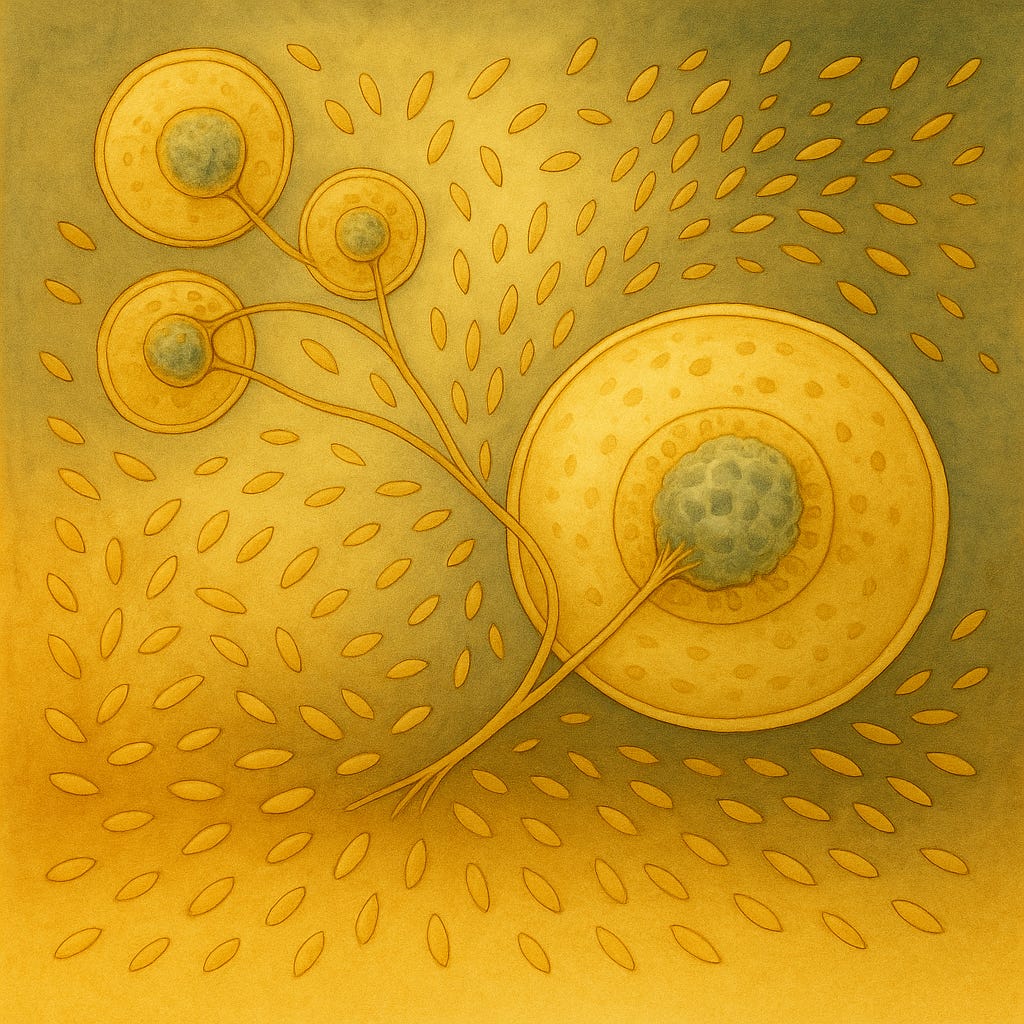

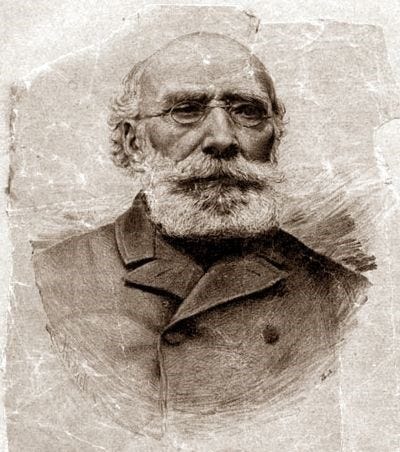
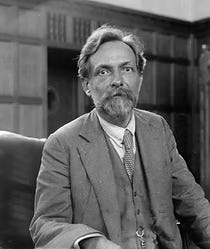
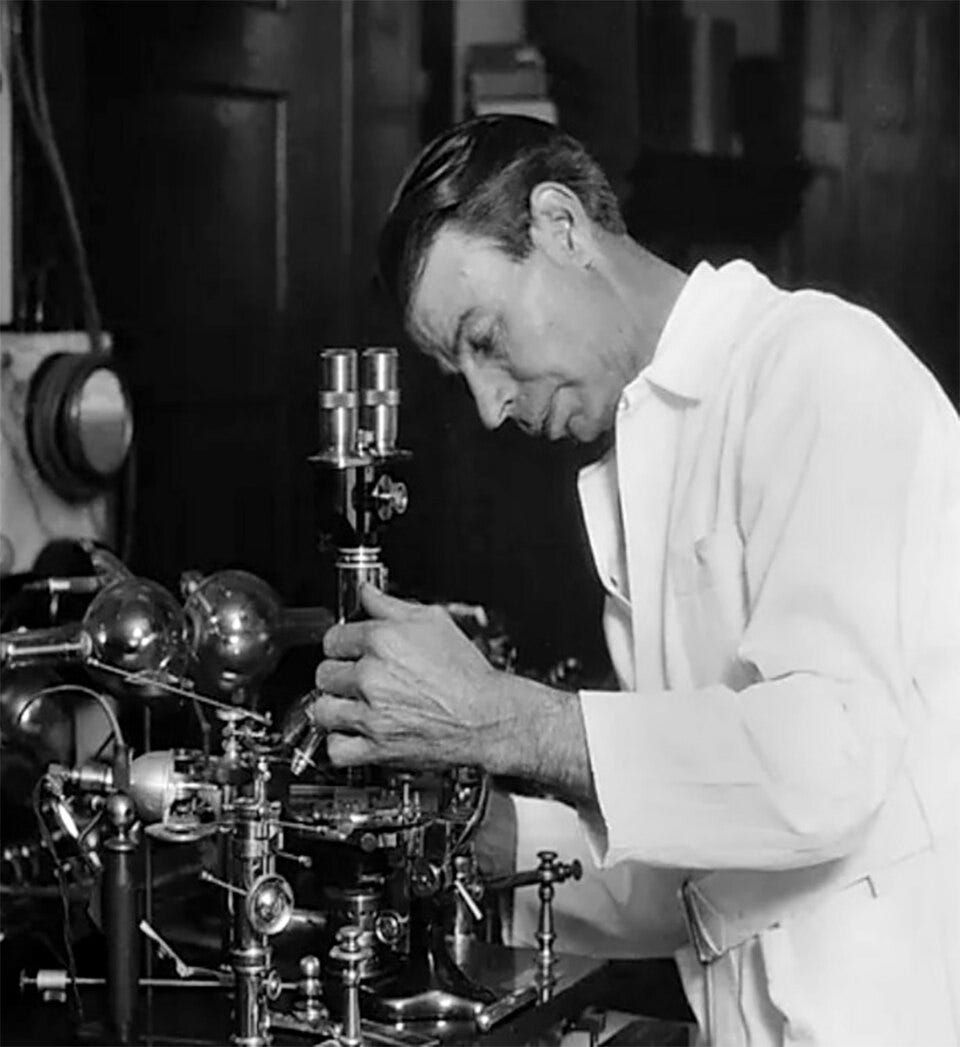
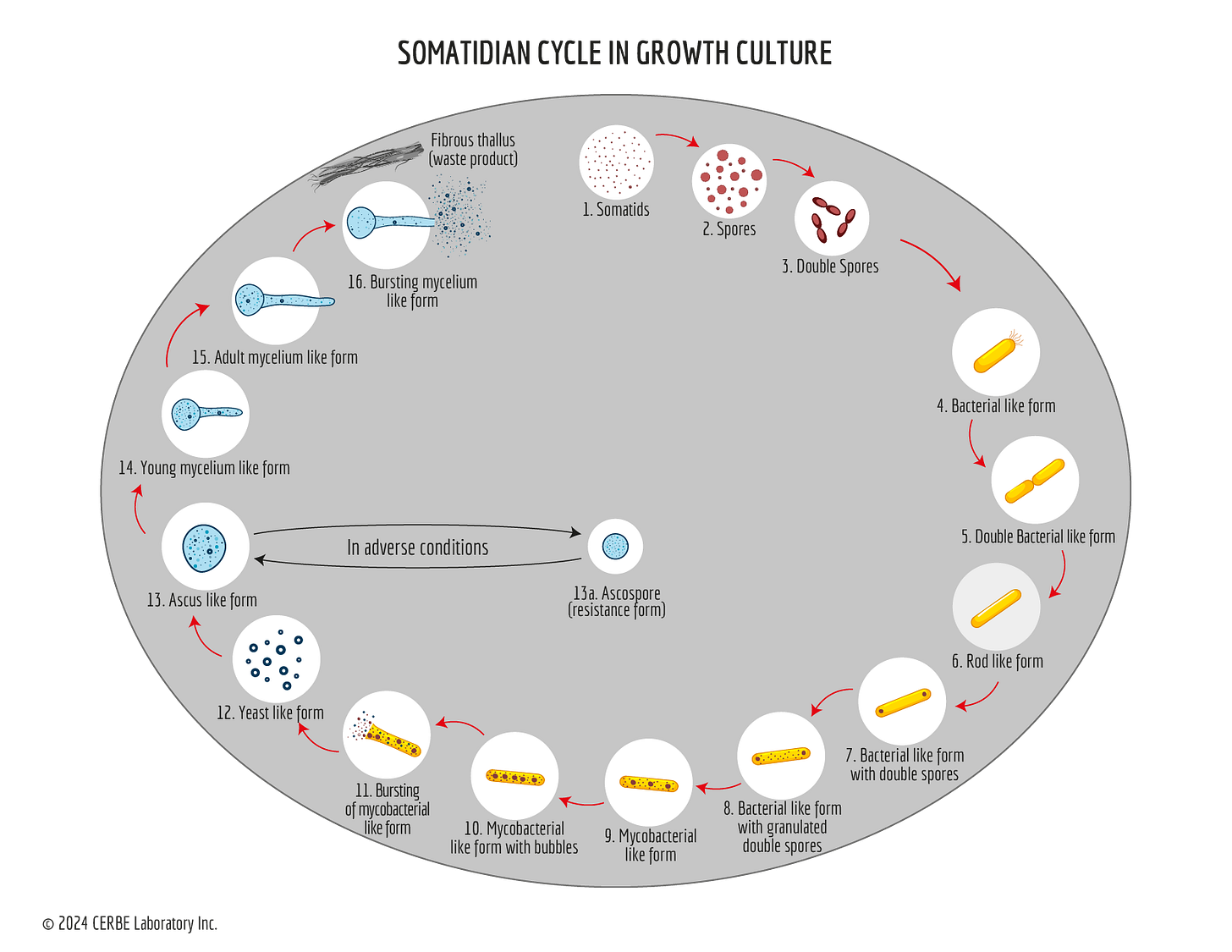
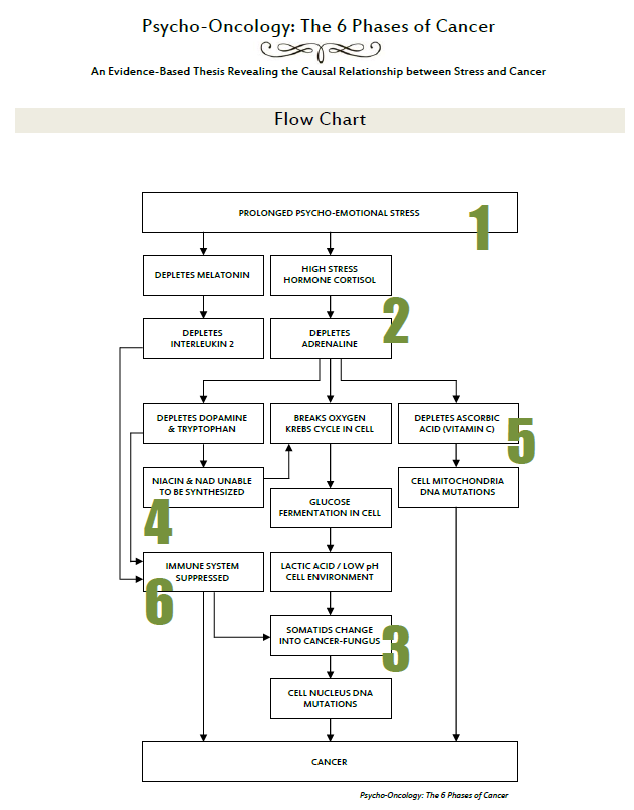




Will be writing on related matters for Arkadia Vitalis at some point. Excited to see you investigating this important subject. I suspect there may be a bit of "blaming the firefighters for the fire" illogical inferring going on here. I'd rather think the body, and the pleomorphic cycle are not stupid or degenerative at any point. My informed intuition remains that cancer is a last ditch effort to sequester toxins the body cannot keep up with expelling and the copresence of seemingly harmful microbes is due to their role in eating/cleansing dead and dying tissue resulting from the same toxicity. I leave room for the cycle getting stuck by environmental factors as well.
Something I ponder from time to time: How do somatids relate to sky critters? As above, so below?
Wilhelm Reiche observed small vessels, often light blue which he called, "bions" These evolved in sterilized vials of dried grass in water. He speculated that these were the spontaneous generation of life from autoclaved organic matter. had he known of the research you have quoted in your article perhaps he would have pushed further into understanding how Orgone fit into this long repressed line of research.
Of course, the implications is that Louis Pasteur was only partly right with his theory of germs and infection, and there's yet another way viruses and cancers arise.
Would that cancers be easily reversible?
Thanks, Tom for another provocative article!